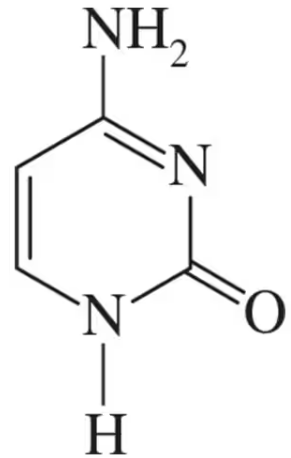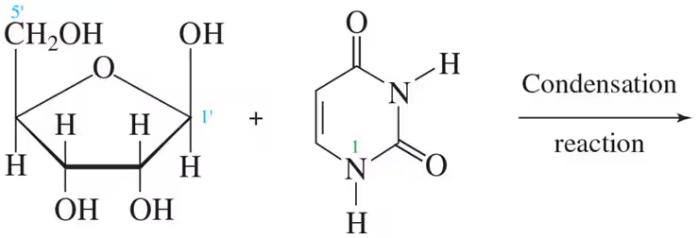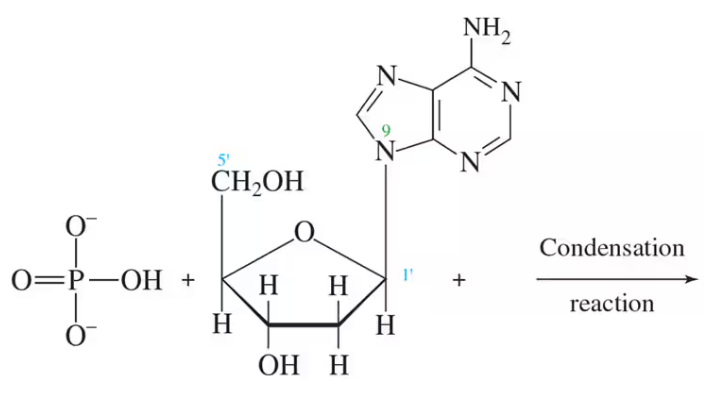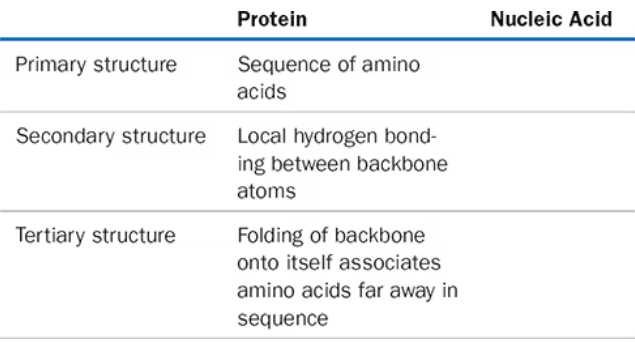 Back
BackProblem 1b
Identify each of the following as a purine or a pyrimidine and name them.
b.
Problem 2a
Identify each of the following as a purine or a pyrimidine:
a. guanine
Problem 5
What is the difference between ribose and deoxyribose?
Problem 8
List the names and abbreviations of the four nucleotides in RNA.
Problem 9a
Provide the products for each of the following condensation reactions:
a.
Problem 10a
Provide the products for each of the following condensation reactions:
a.
Problem 10b
Provide the products for each of the following condensation reactions:
b.
Problem 11
What is the name of the bond that joins nucleotides in a nucleic acid?
Problem 12
Describe the differences in the two ends of a nucleic acid.
Problem 14
Draw the dinucleotide AT that would be found in DNA. Label the 5' and 3' ends of your structure. Identify the phosphodiester bond.
Problem 15
Describe the orientation of antiparallel strands in DNA. Use the terms 3' and 5' in your description.
Problem 17
How are the two strands of nucleic acid in DNA held together?
Problem 19b
Write the base sequence and label the 3' and 5' ends of the complementary strand for a segment of DNA with the following base sequences:
b. 5'CCCCTTTT3'
Problem 20d
Write the base sequence and label the 3' and 5' ends of the complementary strand for a segment of DNA with the following base sequences:
d. 5'CGCGATATTA3'
Problem 21
Fill in the following table with the analogous nucleic acid structures:
Problem 22
List the similarities and differences in the secondary structure of a protein and the secondary structure of DNA.
Problem 23
Name the three types of RNA and their functions.
Problem 24
List the mRNA bases that complement the bases A, T, G, and C in DNA.
Problem 28
The sequence of bases in a DNA template strand is 5'GGCTTATTGCCA3'. What is the corresponding mRNA produced?
Problem 29
Why are there at least 20 tRNAs?
Problem 32b
Provide the three-letter amino acid sequence expected from each of the following mRNA segments:
b. 5'UUU|CCC|UUU|CCC3'
Problem 35b
The following portion of DNA is in the template DNA strand: 3'TGT|GGG|GTT|ATT5'
b. Write the anticodons corresponding to the codons on the mRNA.
Problem 39a
Consider the following portion of mRNA produced by the normal order of DNA nucleotides:
5'CUU|AAA|CGA|GUU3'
a. Write the amino acid sequence that would be produced from this mRNA.
Problem 39c
Consider the following portion of mRNA produced by the normal order of DNA nucleotides:
5'CUU|AAA|CGA|GUU3'
c. Write the amino acid sequence if a mutation changes CGA to AGA. Is this likely to affect protein function?
Problem 39e
Consider the following portion of mRNA produced by the normal order of DNA nucleotides:
5'CUU|AAA|CGA|GUU3'
e. What happens to the protein sequence if an A is added to the beginning of the chain and the sequence changes to 5'ACU|UAA|ACG|AGU3'?
Problem 40c
Consider the following portion of mRNA produced by the normal order of DNA nucleotides:
5'ACA|UCA|CGG|GUA3'
c. Write the amino acid sequence if a mutation changes CGG to GGG. Is this likely to affect protein function?
Problem 40f
Consider the following portion of mRNA produced by the normal order of DNA nucleotides:
5'ACA|UCA|CGG|GUA3'
f. What happens to the protein sequence if the A is removed from the beginning of the chain and the sequence changes to 5'CAU|CAC|GGG3'?
Problem 41b
For each of the following, note whether the component can be found in a virus, a cell, or both.
b. DNA polymerase
Problem 41c
For each of the following, note whether the component can be found in a virus, a cell, or both.
c. capsid
Problem 42a
For each of the following, note whether the component can be found in a virus, a cell, or both.
a. RNA





